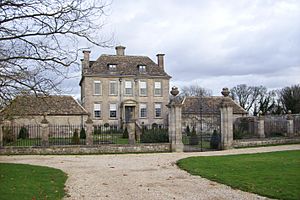Charles Coxe facts for kids
Charles Coxe (born around 1661, died 1728) was an English lawyer and politician. He was a member of the Tory political group. He served in the English and British Parliament from 1698 to 1722. He came from Gloucestershire and owned land there.
Contents
Charles Coxe's Early Life and Education
Charles Coxe was born around 1661. His father was John Coxe from Tarlton, Gloucestershire. At age 13, Charles started studying at St. Edmund Hall, Oxford, a part of Oxford University, in 1674.
In 1677, he began studying law at Lincoln's Inn in London. He officially became a lawyer in 1684. In 1692, he inherited his father's properties.
In 1693, Charles married Catherine Chamberlain. Through her, he gained ownership of the Nether Lypiatt estate in 1699. As a lawyer, he held important positions. He was the Clerk of the Letters Patent from 1699 until his death. He also became a senior lawyer called a serjeant-at-law in 1700.
His Time in Politics
Becoming a Member of Parliament
In 1698, Charles Coxe was elected as a Member of Parliament (MP) for Cirencester. An MP is someone who represents people in the government. He was re-elected without anyone running against him in 1701. However, he was not favored by some because he disagreed with plans for war.
He was elected again in late 1701 and was known as a Tory. He was good friends with a powerful politician named Harley. Because of this friendship, Charles became a judge in 1702 after Queen Anne became queen. He was re-elected for Cirencester in 1702 without opposition.
Moving Up as a Judge
In 1704, Charles Coxe became a chief judge in Brecknock, South Wales. This promotion also happened thanks to Harley's influence.
In the 1705 election, there was a problem in Cirencester. Both Charles Coxe and another candidate, Henry Ireton, seemed to have won. Charles first challenged the result but then decided to step back. This meant Henry Ireton was declared the winner.
Returning to Parliament
Charles Coxe won his seat back in Cirencester in the 1708 election. But his election was later cancelled in 1709. He then successfully won the special election held soon after, on December 23, 1709.
He was re-elected for Cirencester again in 1710. In 1712, his fellow MP from Cirencester, Allen Bathurst, became a lord. For the 1713 election, Bathurst asked Charles Coxe to let one of his brothers run for Cirencester instead. So, Charles moved to run for Gloucester instead, and he won that election.
Later Political Years
When the government changed in 1714, Charles Coxe lost his job as a judge. However, he was still elected as an MP for Gloucester in 1715. During this time, he often voted against the ruling government. He did not run for election in 1722.
Later Life and Legacy
Charles Coxe built the current Nether Lypiatt Manor house in 1717. This house is now considered a very important historical building in England.
He passed away on October 17, 1728, and was buried in Rodmarton. Charles and his wife had four sons and two daughters. He left his house at Lower Lypiatt and his land at Tarlton to his son John. He left his other properties near Cirencester and Stroud to his grandson.
Images for kids



